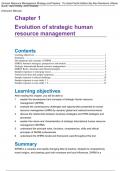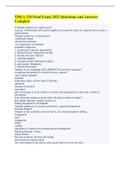(Human Resource Management Strategy and Practice, 11e (Asia Pacific Edition) By Alan Nankervis, Marian
Baird, Jane Coffey, John Shields)
(Instructor Manual)
Chapter 1
Evolution of strategic human
resource management
Contents
Learning objectives .................................................................................................................... 1
Summary .................................................................................................................................... 1
Development and concepts of SHRM........................................................................................ 2
SHRM, business strategies, perspectives and models ............................................................... 3
Strategic international human resource management ................................................................ 4
SHRM: Roles, functions and ethical principles ......................................................................... 5
Sample responses to emerging issues ........................................................................................ 5
Tutorial activities and sample responses.................................................................................... 8
Sample response to ethical challenge ...................................................................................... 10
Sample response to case study 1.1 ........................................................................................... 11
Sample response to case study 1.2 ........................................................................................... 12
Learning objectives
After reading this chapter, you will be able to:
1 explain the development and concepts of strategic human resource
management (SHRM)
2 evaluate the contemporary challenges and opportunities presented to human
resource management (HRM) by dynamic global and national environments
3 discuss the relationship between business strategies and HRM strategies and
processes
4 explain the nature and characteristics of strategic international human resource
management (SIHRM)
5 understand the principal roles, functions, competencies, skills and ethical
principles of SHRM professionals
6 understand the SHRM model and framework used throughout this text.
Summary
SHRM is a complex and rapidly changing field of practice. Despite its comparatively
recent origins, and drawing upon both overseas and local influences, SHRM is a
© 2023 Cengage Learning Australia Pty Limited 01-1
,Chapter 1: Evolution of strategic human resource management Instructor manual
critical factor in the success of all organisations. Modern SHRM is a dynamic
specialisation in the process of refining its philosophies, practices and overall
contributions to organisational effectiveness.
In response to external influences, including globalisation; political,
demographic, technological, pandemic-related and employability challenges; and
significant transitions in the nature of global jobs and workplaces, SHRM and, in
particular, SIHRM, require the adoption of a strategic approach to the management
of human resources for organisational and employee benefit.
As with other professions, SHRM confronts a number of difficult issues and
dilemmas concerning its ethical frameworks, roles, processes and practices. Further
development of SHRM will eventually resolve these issues in creative and effective
ways. The SHRM model presented in this chapter and throughout the book provides
a useful practical framework for exploring these dilemmas.
Student activity 1.1
The introduction to the chapter suggests that developments in business operations
and technology, as well as political, economic, pandemic-related and social changes,
have begun to transform the nature of jobs and workplaces. To help students
understand the human resource impact of strategic business decisions, the following
discussion topics and activities are offered.
Either working in groups or individually, ask students to think about and
discuss the following.
1. Consider and identify the technological developments and workplace changes that
have occurred in a specific industry over the past 10–15 years; for instance,
banking and finance, education, tourism or retail.
2. Examine the HR implications of these developments and changes.
3. List the changes in HRM practices in the fast-moving consumer goods (FMCG)
industry, then discuss the possible pros and cons of such changes and if these
adapted strategies should be retained in the post-pandemic period.
4. Conduct a visioning exercise. Take a specific industry (e.g., manufacturing,
hospitality, telecommunications, etc.) and brainstorm the changes that are likely
to occur within that industry over the next 10–20 years, then explore the HR
implications of the predicted changes.
Development and concepts of SHRM
Student activity 1.2
Ask the students to form four groups and allocate a stage in the development of
SHRM to each. Ask each group to brainstorm the following questions and report
back their ideas.
1. Identify the key events and the significant social, political, economic, industrial
and environmental influences affecting their allocated stage.
2. What impact did these influences have on the way in which human resources
were managed at the time?
© 2023 Cengage Learning Australia Pty Limited 01-2
,Chapter 1: Evolution of strategic human resource management Instructor manual
3. Explain how these events and influences the impact on current SHRM practices in
Australia and globally.
Teaching note
This activity could be undertaken as a small group discussion during class. It could
then be expanded and used as a more intensive research project in which students,
either working in groups or individually, prepare a presentation for the class on each
of the four stages to form a component of assessment.
SHRM, business strategies,
perspectives and models
Student activity 1.3
One of the first questions to ask is: Does HR strategy effectively modify culture or
does culture drive strategy?
To begin exploring this question, ask students to analyse their university,
college or school.
1. How is this institution different from a neighbouring one?
2. What elements of this institution’s strategy are attractive to you?
3. What competitive advantage does this institution offer in comparison with others?
4. What symbols demonstrate the culture of this institution?
5. Do you believe HR strategy has anything to do with the culture or has the culture
driven the strategy?
Although many students may not have a very clear understanding of the
management of their institution, the evaluation of alternative structures, strategies
and culture options could provide greater insight.
1. Do the ways in which organisations arrange themselves significantly influence
culture or does the existing culture determine the nature of such arrangements?
2. Does an organisation’s structure hinder or assist proposed business strategies or
do the strategies themselves determine the appropriate structure of the
organisation?
3. Say you are the HR manager of an organisation that adopted a cost leadership
business strategy. How could you link this strategy with your HR practices? Justify
your response.
Student activity 1.4
This is a useful point at which to engage with the students about their future career
aspirations. It can be surprising to find that many students have not given a great
deal of thought to the structure of their own careers and the roles they wish to play
in business or human resources.
My business career
This activity is a very brief visioning and action planning exercise.
Working individually at first, then in small groups, ask the students to predict
where they will be in two, five and 10 years’ time. Suppose their plans have gone
smoothly; they received the grades they wanted from university, college or school;
© 2023 Cengage Learning Australia Pty Limited 01-3
, Chapter 1: Evolution of strategic human resource management Instructor manual
they have been appointed to the positions they wanted; they have sufficient
resources to keep meeting their needs and so on.
If required, you could use the following questions as prompts:
1. What role will you be working in?
2. Where will you be located?
3. What is the focus of your life?
4. Have you undertaken any additional education?
5. Are you employed in the human resources field? If so why; if not, why not?
Encourage all students to consider their future and to develop an action plan
and specific goals that must be achieved in order for their vision to be fulfilled.
Strategic international human resource
management
Student activity 1.5
Provide students with an opportunity to explore the difficulties involved in
determining how global workforces are managed. Individually or in groups, ask
students to choose a country from a predetermined list (e.g., India, China, Germany,
Italy, Ireland, Japan, Korea, Indonesia, Finland and USA). Alternatively, you can let
them choose any country, but ensure that a range of countries has been selected
(i.e., try to avoid six groups examining China).
Next, ask students to select three HR functions from the list on page 29 (e.g.,
human resource information management system; career management; talent
attraction, selection and retention; work health and safety; industrial relations
management; performance and quality management).
1. List the things a human resources manager at a multinational with employees
based in the chosen country would need to consider.
2. What are the HR policy and practice implications?
3. What is the impact of globalisation on HR policies and practices?
4. What is the impact of technological advances for HR in multinationals?
Ask students to develop an action plan of the strategic considerations needed
and the SIHRM policies and practices that would follow.
Teaching note
This exercise can be used as an in-class activity to help students to begin thinking
deeply about SIHRM and globalisation. Alternatively, the exercise can be expanded
into a larger research project in which students are required to find an organisation,
analyse its HRM strategy, then develop an internationalisation strategy for that
organisation. The students can then explore and justify the HRM strategy (using
research) and the implications for the processes and policies of managing an
international workforce. This exercise can, therefore, form a component of formal
assessment.
© 2023 Cengage Learning Australia Pty Limited 01-4





